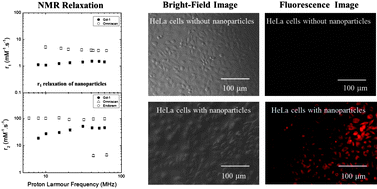Fluorescent and paramagnetic core–shell hybrid nanoparticles for bi-modal magnetic resonance/luminescence imaging†
Abstract
Well calibrated core–shell multifunctional

* Corresponding authors
a
State Key Laboratory on Integrated Optoelectronics, College of Electronic Science and Engineering, Jilin University, Changchun 130012, P.R. China
E-mail:
whdi@jlu.edu.cn, wpqin@jlu.edu.cn
Fax: +86-431-85168240-8325
Tel: +86-431-85168240-8325
b Dipartimento di Fisica, Università degli Studi di Milano, Via Celoria 16, Milano 20133, Italy
c Dipartimento di Fisica “A.Volta”, Università degli studi di Pavia, Pavia 27100, Italy
d CNR-Istituto di Nanoscienze-S3, Modena, Italy
e State Key Laboratory of Luminescence and Application, Changchun Institute of Optics, Fine Mechanics and Physics, Chinese Academy of Sciences, Changchun 130033, P.R. China
f Department of Chemistry, CICECO, University of Aveiro, 3810-193 Aveiro, Portugal
g World Class University (WCU) program of Chemical Convergence for Energy & Environment (C2E2), School of Chemical and Biological Engineering, College of Engineering, Seoul National University (SNU), Seoul 151-744, Korea
h
Materials Processing Unit, National Institute for Materials Science, 1-2-1 Sengen, Tsukuba, Ibaraki 305-0047, Japan
E-mail:
sakka.yoshio@nims.go.jp
i Graduate School of Pure and Applied Sciences, University of Tsukuba, 1-2-1 Sengen, Tsukuba, Ibaraki 305-0047, Japan
Well calibrated core–shell multifunctional

 Please wait while we load your content...
Something went wrong. Try again?
Please wait while we load your content...
Something went wrong. Try again?
W. Di, S. K. P. Velu, A. Lascialfari, C. Liu, N. Pinna, P. Arosio, Y. Sakka and W. Qin, J. Mater. Chem., 2012, 22, 20641 DOI: 10.1039/C2JM34508K
To request permission to reproduce material from this article, please go to the Copyright Clearance Center request page.
If you are an author contributing to an RSC publication, you do not need to request permission provided correct acknowledgement is given.
If you are the author of this article, you do not need to request permission to reproduce figures and diagrams provided correct acknowledgement is given. If you want to reproduce the whole article in a third-party publication (excluding your thesis/dissertation for which permission is not required) please go to the Copyright Clearance Center request page.
Read more about how to correctly acknowledge RSC content.
 Fetching data from CrossRef.
Fetching data from CrossRef.
This may take some time to load.
Loading related content
